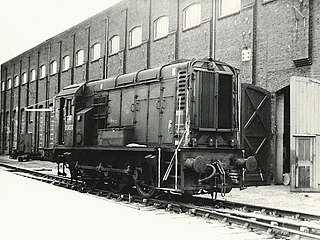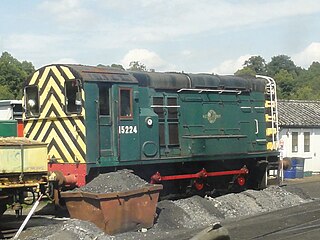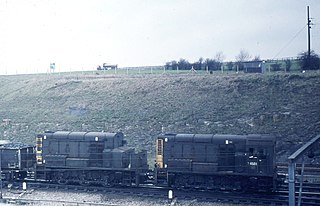History
Originally laid down as a D3/9, the frames were moved from Doncaster Works to Brush Traction's Falcon Works in Loughborough for final assembly. It was completed in September 1947 and undertook trials with LNER in November 1947. In January 1948, it was moved to Temple Mills Yard in London for further trials. It was then moved to March Whitemoor Yard. In December 1948, it was returned to Loughborough and was acquired by British Rail upon nationalisation. [2]
In April 1949, it was delivered to March shed. Whilst based at March, it was used on short freight services between Ferme Park and Herne Hill. It moved to Hornsey Depot in December 1951, however it was moved to Crewe Works later that month. It returned to March in January 1952 and returned to Hornsey in around 1955. In January 1957, it worked at Woodford Halse Shed and New England Shed in Peterborough where it remained until withdrawal in October 1962. [2]
Upon withdrawal, it was moved to Doncaster Works, and was finally scrapped in July 1963. [2]

D0280 Falcon was a single prototype diesel-electric locomotive, built for British Railways in 1961. It was one of a series of three prototypes: Falcon, DP2 and Lion, eventually leading to the Class 47 and Class 50. A requirement was expressed by the BTC at a meeting on 15 January 1960 for new Type 4 designs of Co-Co arrangement, which would be lighter than the earlier 1Co-Co1 locomotives such as the Peak classes, produced under the Pilot Scheme.

The British Rail Class 02 are a class of twenty 0-4-0 diesel-hydraulic shunting locomotives built by the Yorkshire Engine Company in 1960 and 1961 (D2860-D2869) for service in areas of restricted loading gauge and curvature such as docks. They had the door to the cab at the rear, with a railed veranda behind the cab; this feature was very unusual on British Rail locomotives, although it was used on many Yorkshire Engine Co. designs and is quite normal in North American practice.

The British Rail Class 07 diesel locomotive is an off-centre cab 0-6-0 diesel-electric shunter type built by Ruston & Hornsby in 1962 for the Southern Region of British Railways. The 14 members of the class were primarily used at Southampton Docks and later also at Eastleigh Works.

The British Rail Class 08 is a class of diesel-electric shunting locomotives built by British Railways (BR). As the standard BR general-purpose diesel shunter, the class became a familiar sight at major stations and freight yards. Since their introduction in 1952, however, the nature of rail traffic in Britain has changed considerably. Freight trains are now mostly fixed rakes of wagons, and passenger trains are mostly multiple units or have Driving Van Trailers, neither requiring the attention of a shunting locomotive. Consequently, a large proportion of the class has been withdrawn from mainline use and stored, scrapped, exported or sold to industrial or heritage railways.

The British Rail Class 10 diesel locomotives are a variant of the standard Class 08 diesel-electric shunter with a Lister Blackstone diesel engine and General Electric Company plc (GEC) traction motors. The locomotives were built at the BR Works in Darlington and Doncaster over the period 1955–1962, and were withdrawn between February 1967 and June 1972.

The British Rail Class 12 is a diesel locomotive built primarily for shunting duties around London.

The British Rail Class 13 was a type of diesel-electric shunting locomotive. The type was designed in 1965 because of the need to provide more powerful shunters for the Tinsley Marshalling Yard. Due to Tinsley's status as a hump yard, it was not possible to use a single locomotive owing to the risk of grounding. So, to achieve the required power, a pair of Class 08 shunters were permanently coupled in 'master and slave' formation, with the slave unit having had its cab removed. Both units were then ballasted to improve traction. Initially coupled cab-to-cab, it was found more practical to couple master nose to slave cab.

The British Rail Class 89 is a prototype electric locomotive. Only one was built, in 1986, by British Rail Engineering Limited's Crewe Works. It was used on test-trains on both the West Coast and East Coast Main Lines. The locomotive was fitted with advanced power control systems and developed more than 6,000 bhp. After being withdrawn in 1992, it was returned to service in 1996, before being again withdrawn in 2000. As of January 2021, it is in the final stages of an overhaul that will return it to the main line.

The steam locomotives of British Railways were used by British Railways over the period 1948–1968. The vast majority of these were inherited from its four constituent companies, the "Big Four".
The Córas Iompair Éireann 301 Class locomotives were the first diesel locomotives used on the CIÉ network, this class of 5 being built between 1947 and 1948 by the company for shunting use, particularly in the railway yards on Dublin's North Wall. They were a six coupled locomotive, fitted with a Mirrlees TLDT6 engine of 487 horsepower (363 kW) with diesel-electric transmission via two Brush traction motors. Unusually, they lacked train vacuum brakes, although air brakes were provided for the locomotive itself.

The British Rail Class D2/11 was a British class of locomotive designed in 1958 by Brush Traction and Beyer, Peacock & Company, which co-operated to produce five prototype diesel-electric shunting locomotives of 0-4-0 wheel arrangement. They were intended to demonstrate a new generation of diesel shunters for industrial and mainline use. Two were loaned to British Railways for trials and one, number D2999, was subsequently purchased by BR. However, no large scale orders resulted from these demonstrators.
The London, Midland and Scottish Railway (LMS) pioneered the use of diesel shunting locomotives in Great Britain. The variety of experimental and production diesel shunters produced by the LMS is summarised below.
The Great Western Railway purchased two diesel shunters, and ordered a further seven immediately prior to Nationalisation, which were delivered to British Rail in 1948–49. The two shunters used by the GWR were numbered 1 and 2, while a series commencing at 501 was planned for the new locomotives ordered in the 1940s. British Rail renumbered both its inherited and new locomotives in a series commencing from 15100.

The British Rail Class 56 is a type of diesel locomotive designed for heavy freight work. It is a Type 5 locomotive, with a Ruston-Paxman power unit developing 3,250 bhp, and has a Co-Co wheel arrangement. Enthusiasts nicknamed them "Gridirons", due to the grid-like horn cover on the locomotive's cab ends fitted to nos. 56056 onwards. Under its Romanian railway factory nomenclature, the locomotive was named Electroputere LDE 3500, with LDE coming from Locomotivă Diesel-Electrică and the 3500 being the planned horsepower output.
British Rail 15107 was a 0-6-0 diesel-electric shunter locomotive commissioned by the Great Western Railway from its Swindon Works, but delivered to British Railways after nationalisation. It had a Petter 4-cylinder engine. Its shed allocation in 1950 was Western Region, 82B, St Philip's Marsh, Bristol.
British Rail Class D3/9 was a class of four locomotives built by the London and North Eastern Railway at their Doncaster Works in England. It was a diesel powered locomotive in the pre-TOPS period, they could also be used as mobile power stations if required.

British Rail class D3/12 was a class of three experimental diesel-electric shunting locomotives designed by Richard Maunsell of the Southern Railway in 1937. They quickly proved their effectiveness, but the Second World War prevented more of them being built. Oliver Bulleid based the British Rail Class 12 on them in 1949.
British Rail Class D3/10 was a single experimental diesel-electric shunter locomotive commissioned by the Great Western Railway (GWR) in England, and later taken over by British Railways.











